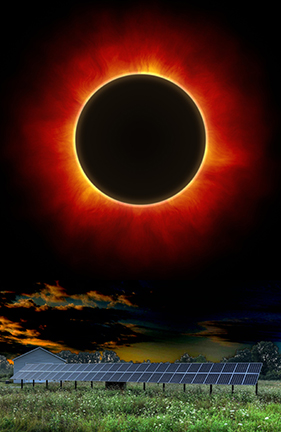
Dark Times Ahead for Solar?
It sounds like a great cosmic conjunction. The kind of thing that has practically never happened in living memory.
Oh yeah —there’s that eclipse-thing, too.
Seriously, who could have imagined a potential solar panel trade war happening during an presidency firmly committed to protecting and promoting fossil fuels. But the fact is that American solar panel companies are struggling against cheap Asian solar panels being dumped into the US market. So, to protect the American solar panel industry, two companies are asking the Trump Administration to help them out. And it looks like the administration might just do that.
BUT to counter the case for trade barriers, the Solar Energy Industries Association (SEIA) has teamed up with the conservative Heritage Foundation and the American Legislative Exchange Council (ALEC), both of which have long histories favoring fossil fuels.
That bitter metallic taste you’re experiencing right now is “irony”.
Bad puns aside, the conjunction of these strange bedfellows will effect the future of solar power in the US — and the industry is nervy.
For about a decade, Chinese and Asian manufacturers racing to compete with rising global demand have created a glut of solar panels. Part of their solution has been to sell these to the US market where the 30% tax credit has dropped the price of utility scale (solar farm sized) installations below $1/watt. The average cost for a 5.6 kW grid-tied residential solar in 2016 was just $15,500 —not including the 30% tax credit. Both the number of installations and the number of solar-related jobs hit records last year. However, with 95% of those cells and panels coming from overseas, two US manufacturers, Suniva and SolarWorld Americas Inc. have a pending complaint filed with the U.S. International Trade Commission under Section 201 of the Trade Act of 1974 asking for limiting Chinese manufacturers’ access to the US by levying a 40¢ per watt tariff on imported cells with a minimum of 78¢ per watt. The ITC will announce its decision in late September.
Suniva filed for Chapter 11 bankruptcy in April and —even more ironic— is majority-owned by the Chinese clean energy company, Shunfeng International Clean Energy (SFCE) —which is the parent company of Suntech, a PV module maker.
If the ITC approves the proposed tariff, it’s estimated that the price hike will kill 50% of all planned solar installations (including those big utility scale projects) through 2022. That adds up to around 47 gigawatts not seeing the light of day.
To prepare for this looming shadow, the solar industry is reacting in different ways. Some installers are stocking up on panels, which has caused a 20% jump in prices. Investors are getting out and some projects are already going on hold.
And if this dark turn of events wasn’t enough for solar energy, the coming total eclipse this August may cut the nation’s electrical supply equivalent to what’s used by 7 million homes.
According to a Bloomberg calculation of grid forecasts, 9,000 MW of solar generation will go down on August 21 as the moon blots out the sun and casts a 70-mile-wide shadow from Oregon to South Carolina. Partial eclipses of 70% or more will effect an even greater area stretching from the southwest to New York City and westward over the upper plains. Bloomberg warns that prices could spike in the wholesale markets, particularly as mid-August heat drives up air conditioner usage.
Because solar power is now shouldering more of the nation’s electrical load, utilities anticipate a sudden increase in load during the eclipse that could emerge in less than five minutes as solar arrays on homes, businesses, warehouses, and factories go off-line. The North American Electric Reliability Corporation (NERC) is forecasting that the four states that “may require advanced system coordination for operations prior to the eclipse, during the eclipse, and after the eclipse are Utah, California, Nevada, and North Carolina.”
In Texas, ERCOT expects to lose 600 MWof solar generation. While that might in itself do much to affect Texas electricity rates, it might nudge rates a little higher than average for brief period of time.
While this news certainly sounds darkly foreboding, the next total eclipse on April 8, 2024, will take the moon’s shadow northeasterly through Texas, Illinois, Indiana, New York and northern New England. By then, there’s the potential for more utility scale solar farms and individual residences to be affected.
